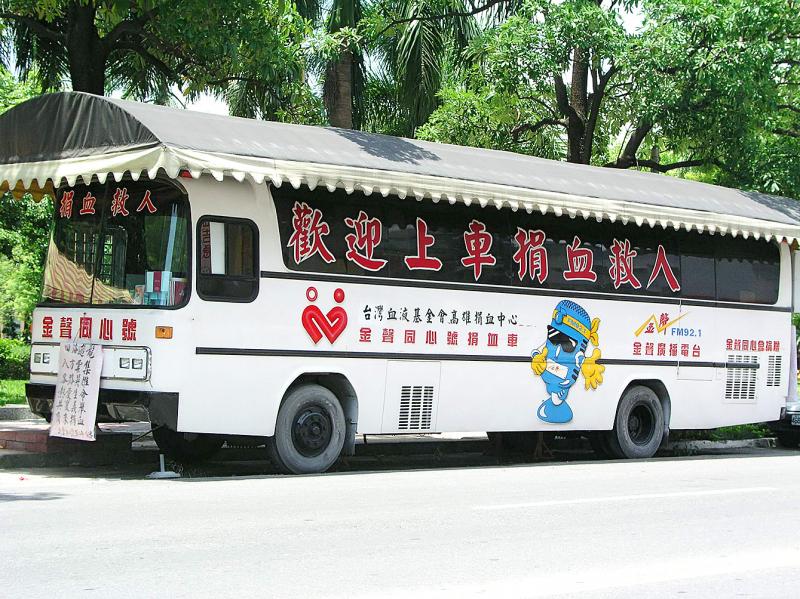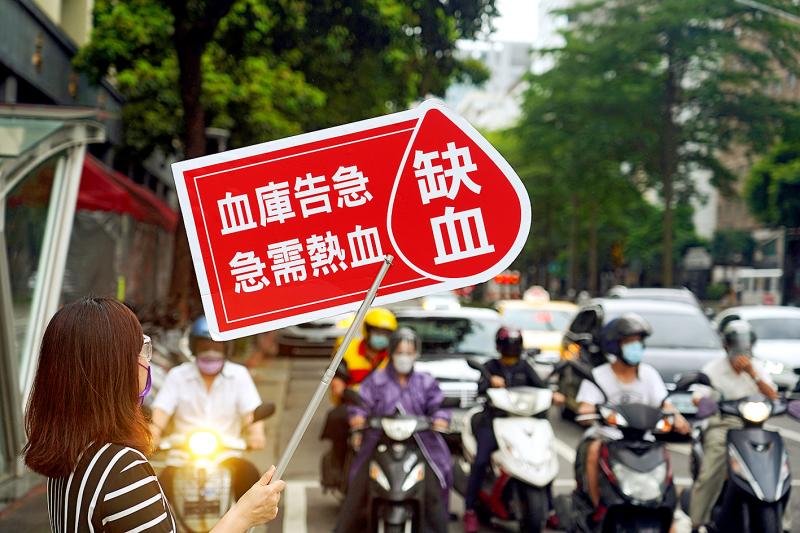Aug. 23 to Aug. 29
A poorly-lit room in the basement of Taipei Veterans General Hospital was constantly packed with people from all walks of life during the late 1970s — and none of them were here for medical problems.
“They all had this unusual look in their eyes, as if they were trying to hide something,” according to an essay titled Blood Seller (賣血人), which appeared in a 1980 Taipei Medical University publication. “Is it the difficulties in their lives? Or is it because of societal perceptions that selling one’s blood isn’t a very dignified thing to do?”

Photo courtesy of Mackay Memorial Hospital
Commonly referred to as “blood cows” (血牛), these people were in fact among the main providers for Taiwan’s blood banks until the early 1990s. In 1978, Taipei Veterans General Hospital acquired about 90 percent of its supply through blood cows, according to the essay. Not every hospital relied so much on this system: National Taiwan University Hospital only purchased about one-fourth of its supply that year through about 8,000 registered sellers. The rest they were able to acquire through donations.
The blood cows were paid NT$2,000 (about NT$12,500 today) for the maximum of 500cc, and were allowed to do it again after two months. Some were on standby for emergencies, and rushed to the hospital if they received a call.
“It’s very tempting to be able to receive a wad of cash for just 10 minutes of your time,” the essay continued. “If they were registered at several hospitals, they could give blood every few days and make a considerable living that way.”

Photo: CNA
After returning to Taiwan in 1981, Mackay Memorial Hospital hematologist Marie Lin (林媽利) spent over a decade trying to eradicate this practice and promote blood donations, finally establishing a unified blood donation system and proper blood bank management procedures that are still used today. By 1992, blood cows no longer existed.
Lin has received many honors over the decades, and was in the news earlier this month as she and her “blood bank women corps” were featured on a stained glass plaque outside Mackay Memorial Hospital’s blood bank as part of a campaign to highlight landmarks of female achievements. On the plaque, she was referred to as the “mother of blood transfusion medicine.”
TRICKED INTO MEDICINE?

Photo: Lee Kai-chu, Taipei Times
Lin was born in 1938 in Yilan to a Taiwanese father and Japanese mother. The family soon moved to Japan and Japanese-occupied Manchuria before returning to Taiwan in 1947.
She wanted to study Chinese literature in college, but her parents strongly objected. Finally, her mother said, “Why don’t you go to medical school first, then you can study literature afterward?”
“I fell for her trap,” Lin writes.

Photo: CNA
Her high school teacher was in favor of women becoming doctors, suggesting they could open a clinic in their house so they could take care of patients and their family at the same time. Of course it’s not that easy, and Lin spent her life struggling to balance the two spheres, which she writes extensively about in her autobiography.
During her fourth year at Kaohsiung Medical University, Lin was diagnosed with aplastic anemia, which required blood transfusions. Without a proper system then, she relied on donations from several of her teachers and colleagues — little did she know that decades later, her name would become synonymous with donating blood.
Lin continued her studies at National Taiwan University Hospital’s department of pathology, and also married her first husband during this time. She recalls that the day before she gave birth to her first son, she was still lifting heavy cadavers for dissection. After she had her second son, she was so busy that she came down with tuberculosis due to overexertion.

Photo: Chen Wei-jen, Taipei Times
Lin spent two stints at the University of Texas Medical Branch in Galveston, graduating in 1981 and obtaining both medical and pathologist licenses. It was a tough decision whether to return to authoritarian Taiwan, but she eventually relented due to her husband and mother’s requests.
GRADUAL REFORM
Upon her return, Lin wanted to work as a hematopathologist, but there were few openings available and she reluctantly accepted a position as a clinical laboratory scientist at Mackay Memorial Hospital’s blood bank. She recalls that the bare-bones lab had nothing but a table, a fridge, a microscope and a centrifuge.
Lin immediately saw a major problem with the blood cow system. Not only was there no standard for the transfusion process, there was also no control over the blood’s quality, leading to many transfusion-related hepatitis B cases.
Plus, since the hospitals depended on these blood cows so much, Lin recalls that they often had to pander to them in times of duress — one hospital even offered living quarters for their providers. Lin vowed to change Taiwan’s blood bank system and model it after what she saw in the US.
“There were always a bunch of blood cows waiting in the room … Some sold blood to multiple hospitals, and their blood became very diluted. But we still had to use their blood because there were no other options,” Lin writes.
Author Chen Ming-pan (陳銘磻) did an in-depth piece on blood cows in 1979, painting them in a more sympathetic light as people who simply fell on hard times and needed to make ends meet. Chen had a friend who was in dire need of blood during surgery, and luckily there were two blood cows on scene who saved his life.
The bigger problem, to Chen, were the “blood brokers” who earned a cut of the profits by acting as a go-between.
In 1983, the government invited New York Blood Center director Aaron Kellner to visit Taiwan and inspect its blood supply system. Kellner suggested that Taiwan should employ a unified, government-regulated system that only accepted donated blood, and that it should start training specific blood transfusion technicians.
Lin began spending a day each week improving practices at the Blood Donation Association, and also frequently appeared on television and other media to promote blood donation. She was terrified of public speaking, but tirelessly explained that “blood donation is not harmful, blood is priceless and should not be sold, and donating blood can save lives.”
From 1984 to 1985, Lin helped conduct Taiwan’s first national inspection on its blood banks. Lin recalls becoming furious upon seeing horrific conditions and sloppy procedures, and later these inspections were expanded to all clinical lab work in the hospitals. The results made up 10 percent of the hospital’s annual evaluation score, forcing them to take the matter seriously.
The nation’s blood donation center back then was inexplicably under the Ministry of the Interior and headed by old Chinese Nationalist Party (KMT) officials without medical background. Lin strongly pushed for the formation of what would become today’s Taiwan Blood Services Foundation.
“The whole process was gradual; we slowly pushed for changes within the boundaries of what people could accept,” Lin writes. “There was no revolution. I think that’s very important to me, because I don’t like conflict.”
Lin is thankful the government was willing to make the effort back then — the HIV epidemic was sweeping across the world, and the results would have been disastrous.
By 1995, Lin decided that her task was complete, and returned to researching full time at Mackay. Her work on blood types and Taiwanese genetics received much attention (and criticism) over the next few decades, but that’s another story.
Taiwan in Time, a column about Taiwan’s history that is published every Sunday, spotlights important or interesting events around the nation that either have anniversaries this week or are tied to current events.

Oct. 27 to Nov. 2 Over a breakfast of soymilk and fried dough costing less than NT$400, seven officials and engineers agreed on a NT$400 million plan — unaware that it would mark the beginning of Taiwan’s semiconductor empire. It was a cold February morning in 1974. Gathered at the unassuming shop were Economics minister Sun Yun-hsuan (孫運璿), director-general of Transportation and Communications Kao Yu-shu (高玉樹), Industrial Technology Research Institute (ITRI) president Wang Chao-chen (王兆振), Telecommunications Laboratories director Kang Pao-huang (康寶煌), Executive Yuan secretary-general Fei Hua (費驊), director-general of Telecommunications Fang Hsien-chi (方賢齊) and Radio Corporation of America (RCA) Laboratories director Pan
The consensus on the Chinese Nationalist Party (KMT) chair race is that Cheng Li-wun (鄭麗文) ran a populist, ideological back-to-basics campaign and soundly defeated former Taipei mayor Hau Lung-bin (郝龍斌), the candidate backed by the big institutional players. Cheng tapped into a wave of popular enthusiasm within the KMT, while the institutional players’ get-out-the-vote abilities fell flat, suggesting their power has weakened significantly. Yet, a closer look at the race paints a more complicated picture, raising questions about some analysts’ conclusions, including my own. TURNOUT Here is a surprising statistic: Turnout was 130,678, or 39.46 percent of the 331,145 eligible party

The classic warmth of a good old-fashioned izakaya beckons you in, all cozy nooks and dark wood finishes, as tables order a third round and waiters sling tapas-sized bites and assorted — sometimes unidentifiable — skewered meats. But there’s a romantic hush about this Ximending (西門町) hotspot, with cocktails savored, plating elegant and never rushed and daters and diners lit by candlelight and chandelier. Each chair is mismatched and the assorted tables appear to be the fanciest picks from a nearby flea market. A naked sewing mannequin stands in a dimly lit corner, adorned with antique mirrors and draped foliage

The election of Cheng Li-wun (鄭麗文) as chair of the Chinese Nationalist Party (KMT) marked a triumphant return of pride in the “Chinese” in the party name. Cheng wants Taiwanese to be proud to call themselves Chinese again. The unambiguous winner was a return to the KMT ideology that formed in the early 2000s under then chairman Lien Chan (連戰) and president Ma Ying-jeou (馬英九) put into practice as far as he could, until ultimately thwarted by hundreds of thousands of protestors thronging the streets in what became known as the Sunflower movement in 2014. Cheng is an unambiguous Chinese ethnonationalist,